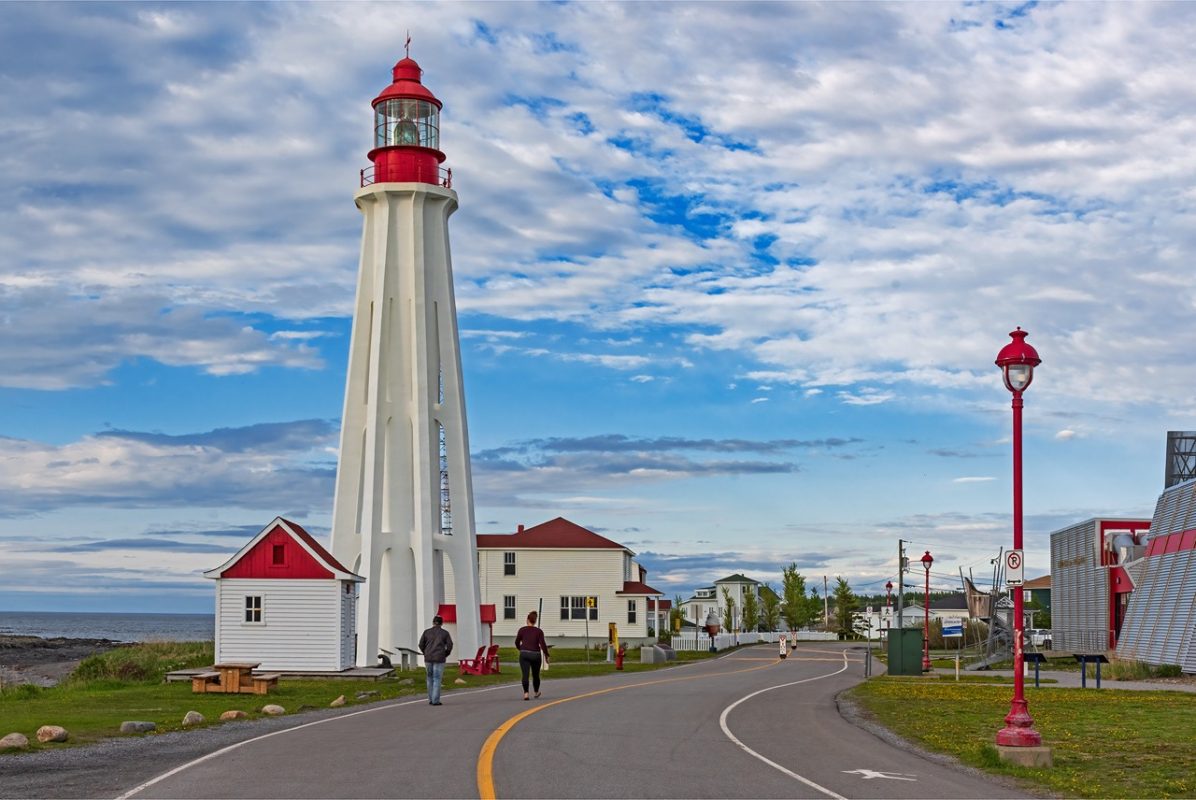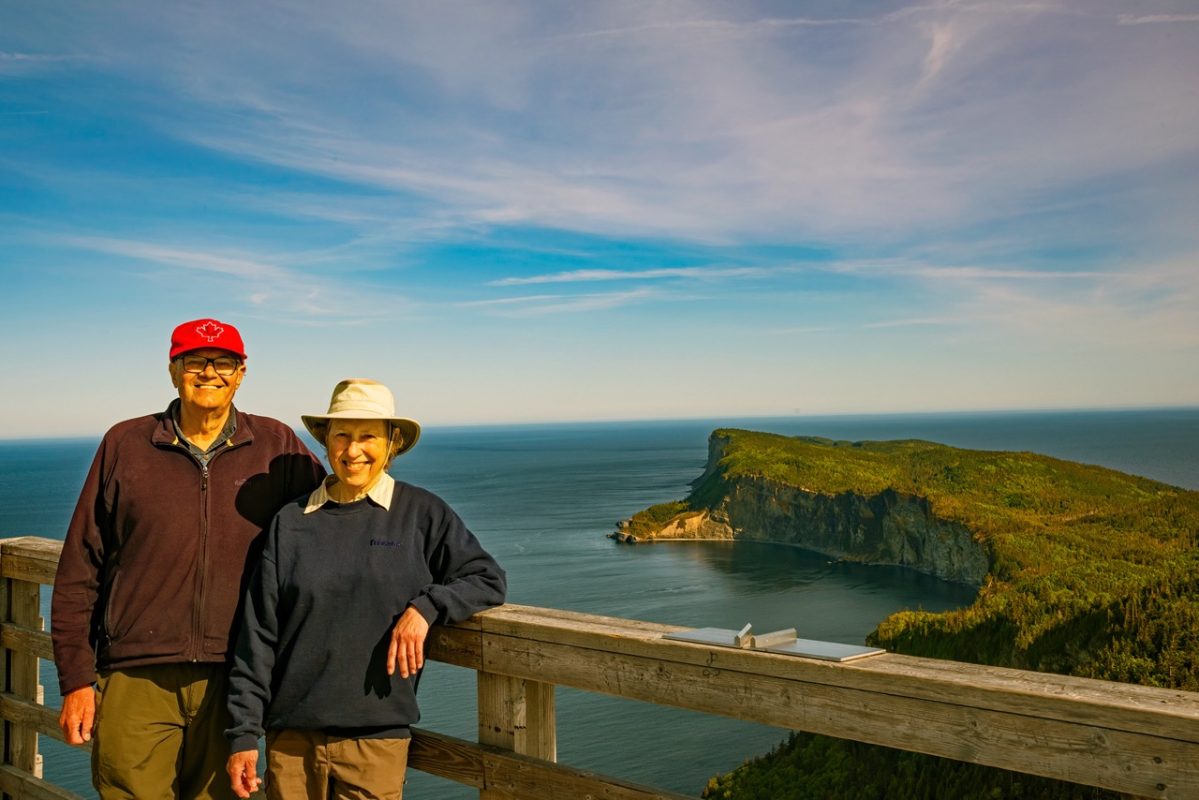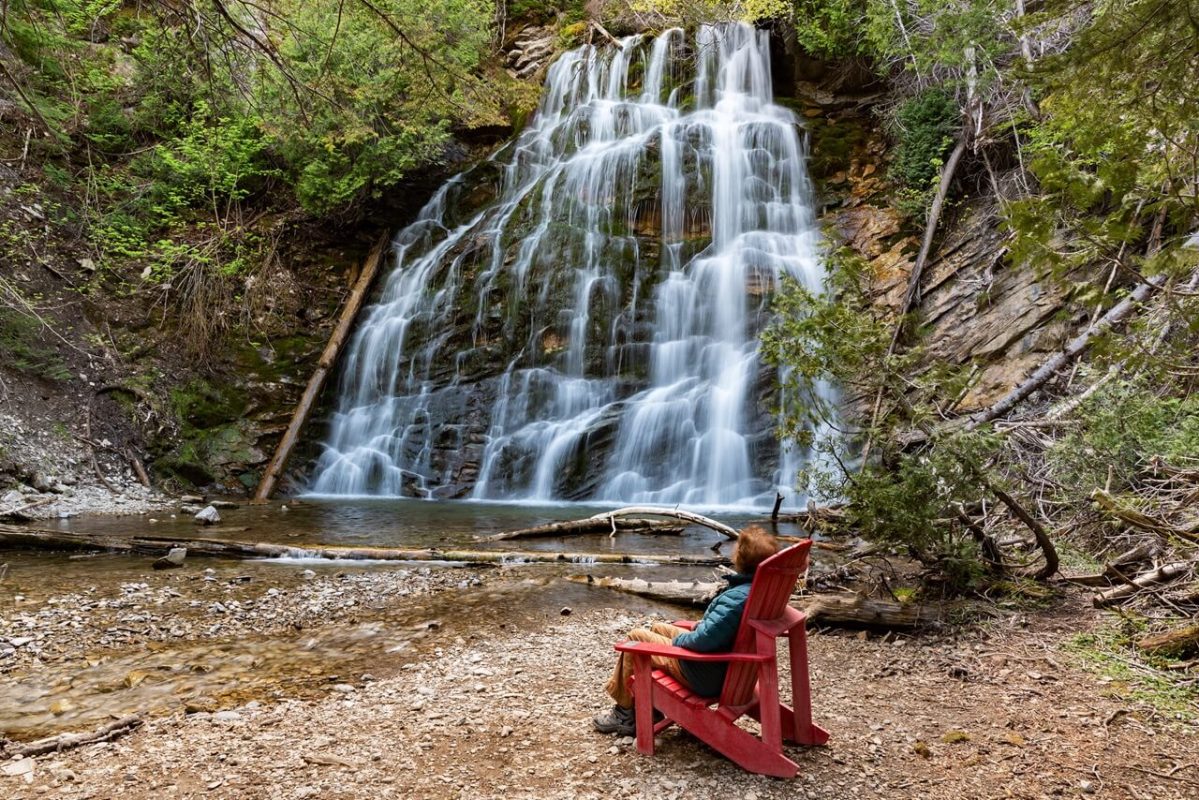To put in perspective, the Gaspé Peninsula is slightly larger than Belgium, meaning there is a remarkable amount to do and appreciate. Robin and Arlene Karpan are intimately familiar with this region, and they’re here to let you know how to make the most of a road trip there.

Driving the coastline of Quebec’s Gaspé Peninsula ranks among Canada’s greatest road trips. This stunning region of southeastern Quebec is among the most unbelievably beautiful destinations in Quebec. The 1,000 kilometres or so from Quebec City to the border with New Brunswick is packed with outstanding landscapes, history, parks, wildlife preserves, and adventure possibilities.
Your Gaspé Road Trip Options
It’s part of Quebec’s Lighthouse Trail, where we find Canada’s highest and second-highest lighthouse, plus a string of others in scenic settings.
On the 200-kilometre stretch from Levis, just across the river from Quebec City to Rivière-du-Loup, we have the choice of two parallel highways.
The faster Trans Canada Highway (A20) runs slightly inland, while the slower and more scenic Highway 132 runs mostly along the St. Lawrence shoreline, passing through small communities such as Rimouski and Sainte-Anne-des-Monts where you can find the fabulous Exploramer marine museum. This route also passes by scenic farmland backed by hills.
Among the many cool stops is Saint-André-de-Kamouraska, where Parc de l’Ancien-Quai is home to the smallest and cutest lighthouse along the route.
Nature buffs, especially birders, should stop at Parc côtier Kiskotuk just outside Rivière-du-Loup, which preserves several fragile coastal ecosystems. Hiking and biking trails lead to a large salt marsh, salt-grass meadows, and forests, while viewing towers offer a chance to see the area from a different perspective.
Nature and History at Parc National du Bic and Rimouski

At Rivière-du-Loup, the Trans Canada Highway heads inland towards New Brunswick, while Highway 132 becomes the main coastal road around the peninsula.
Along this next stretch, it is an absolute gem not to be missed. Parc National du Bic preserves a stunning landscape of bays, coves, islands, and mountains and is known as a top spot for seabirds, basking seals, and other wildlife. The vast network of hiking trails brings many to the park. One that we especially enjoyed was the Chemin-du-Nord Trail along the coastline to some of the park’s signature rock formations.
From Bic, it’s a short drive to Rimouski, the largest centre along the Gaspé coast. It combines urban attractions with easy access to surrounding natural areas. A must-visit here is Pointe-au-Père Lighthouse National Historic Site. The 33-metre-tall lighthouse is the second-highest in Canada, with eight buttresses supporting the tower. You can climb it during summer openings.
Next door is the Pointe-au-Père Maritime Historic Site. It tells the story of the Empress of Ireland, considered Canada’s greatest maritime tragedy. The ship belonging to the Canadian Pacific Steamship Company sank off the shore of Pointe-au-Père in 1914 after colliding with another ship in thick fog. Over 1,000 lives were lost.
Also on the same site is the Onondaga submarine, Canada’s first publicly accessible submarine. This 90-metre craft crisscrossed the North Atlantic between 1967 and 2000 and is now preserved as a historic site.
Please note: This post may contain some affiliate links. That means we may get a small commission for some of our recommendations at no extra cost to you.
Lighthouses Galore Along Gaspé’s North Shore


We really enjoyed the long stretch of highway from Rimouski along the north shore of the Gaspé Peninsula. In many places, the highway is sandwiched in a narrow strip between the water’s edge of the Gulf of St. Lawrence and the mountain cliffs. We pass through a series of picturesque villages, likewise spread along the shore and backed by mountains.
Charming lighthouses dot the route, such as at Matane and Cap Madeleine. The lighthouse at La Martre stands out because of its brilliant red colour. The one at Cap-Chat is named for the cape where it is located, said to resemble the shape of a cat.
The Pointe-à-la-Renommée Lighthouse, also called “the travelling lighthouse,” has an important historical connection. In 1904, this site was chosen by wireless telegraph pioneer Guglielmo Marconi as the first maritime radio station in North America. Decommissioned in the 1970s, it was dismantled and transported to Quebec City, where it was reassembled to serve as a tourist attraction. In 1997, it was returned to its original location and designated as a historic site. It sits high on a remote precipice, keeping watch over seemingly endless sea and sky.

The big daddy of the lighthouse route is Cap-des-Rosiers, Canada’s tallest at 34 metres, standing near the entrance to Forillon National Park. It was built between 1853 and 1858, then rebuilt in 1984 and covered with white marble. It is now a national historic site which you can visit in summer and climb to the top for outstanding views.
Exploring Forillon National Park
This park alone is worth the trip. Jutting out from the northeast point on the Gaspé Peninsula, Forillon National Park is packed with forested mountains, breathtaking cliffs, wildlife galore, and amazing vistas at every turn. Topping the list of scenic views is the sunrise at Cap-Bon-Ami. While striking anytime, at daybreak, the rising sun bathes the imposing east-facing cliffs in a brilliant golden glow.
Hiking & Walking

The park’s outstanding hikes vary from half-hour short walks, such as to an impressive waterfall on La Chute Trail, to challenging treks deep into the backcountry. A couple of day hikes are absolute must-dos. The park’s signature hike is the Mont-Saint-Alban Trail, with an elevation gain of 280 metres. We end at a tower with sweeping vistas in every direction, including the park’s iconic lookout over the cliffs at the tip of the peninsula known as Land’s End.
Les Graves Trail extends along those cliffs to Land’s End, so-named for being the northern end of the International Appalachian Trail, which runs along the Appalachian Mountains to Georgia in the USA. A highlight is Cap-Gaspé Lighthouse, standing near the end of the trail atop a 95-metre-high cliff.
Hikers frequently see wildlife, such as black bears or moose, along this trail. But we did one better and saw whales! For much of our walk along the cliffs, we could see and hear Minke whales just offshore.
On the Water

Since this is known as a whale-watching hotspot, we took a trip with Croisières Baie de Gaspé, based in the park.
Soon after we left the dock, we spotted several more Minke whales, along with porpoises, seals, and a variety of seabirds. Other species that sometimes visit these waters include the Fin whale, Humpback whale, and Blue whale. At the end of the peninsula, we cruised by the spectacular cliffs of Land’s End, providing a distinctly different vantage point than from the hiking trail.
Kayaking is another great way to get out on the water. We jump at the chance to go paddling anytime, but when we can combine it with scenery and wildlife, all the better. An early morning paddle with Cap Aventure, whose specialty excursion goes past a seal colony, was just what we were looking for.
We passed several harbour seals lounging on the rocks and swimming near shore. Our experienced guide, Vincent, was adept at getting us close enough for photos but not too close as to disturb them.
History & Culture

The most unusual aspect of Forillon is its role in World War II. German submarines sank 23 Allied ships near these shores, so the Canadian Navy built a base in Gaspé Bay and set up coastal batteries. Parks Canada has preserved the Fort Peninsula Battery, so we can wander through the trenches, see two of the massive guns, and learn how this war came close to home.
On the other side of Gaspé Bay from Forillon, we come to the small city of Gaspé, where history looms large. It was here in 1534 that explorer Jacques Cartier set up a cross, claiming the land for the king of France. A historic site and monument in Gaspé is even called the Birthplace of Canada. This is also home to the Gaspésie Museum, which celebrates the history, identity, and culture of the Gaspé region.
Percé: Dynamite Scenery and a Wildlife Extravaganza

Percé is the most famous Gaspé destination. The town’s main claim to fame is Percé Rock, an imposing limestone island reaching 85 metres high, close to a half-kilometre long, and pierced with a 30-metre-wide hole.
Though we’ve seen the rock in countless pictures, it still came as a surprise when we drove down the last hill into town and saw the great monolith looming just offshore.
Like so many coastal Gaspé towns, Percé is long and narrow, spread between the sea and nearby mountains. A boardwalk with benches and parks lines the beach, where visitors relax and enjoy the atmosphere. Along the way, we pass historic houses of sea captains from the golden age of the cod fishery.
Percé was recognized as a UNESCO Global Geopark in 2018 because of its geological significance and rich wildlife. The visitor centre brings to life the ancient tectonic events that shaped the land and how it relates to Percé Rock and other features.
Much of the Geopark lies up the mountain slopes from town. Trails wind through the hills, where you can either wander on your own or take a Geopark guided tour. The highlight is the suspended glass platform that juts out from the cliff face 200 metres above the town, offering magnificent views.

Percé not only has one of eastern Canada’s most iconic landmarks but also one of the top wildlife spectacles in North America. Only four kilometres from Percé, Bonaventure Island is an important park and seabird sanctuary protecting a variety of species, most notably the largest and most accessible northern gannet colony in North America.
We visit the island on a boat trip with Les Bateliers de Percé, which begins by slowly cruising near Percé Rock and then circling Bonaventure Island. It’s a mesmerizing sight as we pass the 75-metre-high cliffs where it seems that perching birds occupy every available ledge and niche – mostly brilliant white northern gannets but also common murres, razorbills, black guillemots, among others. Thousands more birds fill the air all around us, like something out of a Hitchcock movie. But the best was yet to come.
After the boat docks, we’re free to wander the island’s network of trails and can stay as long as we want – we just need to be back in time to catch the last boat to Percé. A 3-kilometre walk takes us to the main cliff-top gannet colony, the same one that we passed by boat less than an hour earlier.
The first sight of the nesting colony is enough to take your breath away as thousands of tightly packed white gannets sprawl across the craggy plateau. Park staff tell us that around 125,000 gannets are here, along with numerous other species. We spend a few hours watching and photographing the constant activity at remarkably close quarters as the gannets fly around, bring back nesting material, engage in greeting rituals, and occasionally squabble.
This trip has been filled with memorable experiences, but we would put this at the head of the list.

Chaleur Bay: One of Canada’s Most Beautiful Bays
Heading south and west from Percé, we soon come to the south coast of the Gaspé Peninsula and Chaleur Bay, the inlet between Gaspé and New Brunswick.
The bay has some of the warmest water along the Atlantic coast. Its many beaches, such as those at Carleton-sur-Mer, are popular seaside resorts. The route offers even more pleasant villages, lighthouses, wildlife preserves, hiking in the hills at Mont-Saint-Joseph, and historic sites. Near the end of the bay at Pointe-à-la-Croix, the Battle of the Restigouche National Historic Site commemorates the last battle between France and Britain for possession of North America in 1760.
To top it off, Chaleur Bay often makes the list of the world’s most beautiful bays. A fitting end to a drive filled with almost non-stop remarkable places.
Where to Stay on Your Road Trip on the Gaspé Peninsula

This route abounds with numerous hotels, inns, resorts, bed & breakfasts, and campgrounds. Here are a few places that we enjoyed.
Motel Bienvenue (Rimouski). Comfortable and recently refurbished, with several units having full kitchen facilities. Best of all, it’s right beside the Pointe-au-Père historic site, ideal for sunrise or sunset photography over the lighthouse and coastline.
Hotel-Motel Fleur de Lys (Percé). Talk about a room with a view. It’s right on the beach where we can see Percé Rock from our front window and a short walk to the boat dock, a variety of restaurants, and other services.
Parc National du Bic – Stay right in the park to be close to trails and other services. In addition to regular campsites, the park has cabins and yurts, and even “ready-to-camp” tents already set up so you don’t need camping gear.
Forillon National Park – Three campgrounds have fully serviced and non-electric sites, as well as oTENTiks. We stayed in Des-Rosiers Campground next to the Gulf of St. Lawrence. From here, it’s only a few minute’s drive to Cap-Bon-Ami, with its amazing sunrises.
The Gaspé Peninsula Awaits


We hope this helps you plan the ultimate Gaspé Peninsula road trip and truly discover one of the most beautiful parts of this country because, as you can see, there’s so much to explore.
You May Also Like To Read:

Robin and Arlene Karpan are award-winning writers, photographers, bloggers, and authors of several travel books, including Canadian Bestsellers. Their work has appeared in over 100 publications around the world. While their travels have taken them to all seven continents, they find that some of the most compelling destinations are close to home in Canada. They have a special interest in the natural world and outdoor photography. Robin and Arlene publish the travel blog Photo Journeys which looks at travel through a photographer’s lens, and is rated by Feedspot as among the Top 100 Travel Photography Sites.



We are planning a trip in September and wondering if we should come by car or travel with our 5th Wheel Trailer? Our concern is the hills and rugged terrain we have read about. Would appreciate any info you might have. Thanks so much.
Hi Sandra, great question! The roadtrip to Gaspesie is very trailer-friendly, although it is hilly. If your vehicle can handle the ups and downs, it’s a great destination for a fifth-wheel.